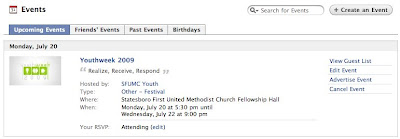This post is part of a series on Using Technology to Further Relationships in Youth Ministry.
Social networking websites such as Facebook and MySpace seem to be everywhere. The growth in popularity of these sites has been huge in recent years. You can read all about Facebook for yourself. I'll just say, anytime somebody starts a project and there's discussion of it being purchased for an amount of money that uses the word "billion", that's a successful project.
Here I'll be writing about Facebook (rather than MySpace) for a few reasons:
- First, because that's what I use.
- This is entirely opinion, but I prefer the Facebook aesthetic; simpler, cleaner, and ads aren't as intrusive.
- In terms of fostering relationships and building community, Facebook trumps MySpace. I'll explain a couple reasons why in just a moment.
- Who you can reach on any social networking site will be limited to those that use it, but for me that's where most of the teens I work with are.
GROUPS
Facebook allows people to setup "group pages." Users can choose to join groups. This allows the group administrator (one person or a group of people) the ability to do several things:
- Message all group members at once. Don't overuse this, because it feels "spammy" to group members, but if there are important messages I want to spread fairly quickly this helps.
- Update a "recent news" section of the group page. When I type up announcements for the bulletin or newsletter, I copy and paste them into here. One more point of communication.
- There's an officers list. This might be a place to list Youth Ministry staff, a student leadership team, key volunteers, or even funny fake made-up titles for the senior pastor. Sometimes it's helpful to let people know who does what or fills certain roles.
- Provide basic contact information for the group. Something as simple as having church phone number, address, or email addresses can be super helpful for people sometimes.
Also, group members can post photos, videos, website links, or talk back-and-forth on the "wall" or a discussion board. A Facebook group page could function as your youth ministry's very own website. (Note: If someone does not have a Facebook account, they may still be able to view the page, but would be very limited in their interaction.)
From your Facebook Home page, you'll see the Facebook Groups icon in the bottom left of the screen:
Clicking this will take you to a listing of groups:

Here's an example of a group page from our youth ministry's group page:

Bottom line: Facebook Group pages are a great opportunity to provide information and interact online with youth who use Facebook.
EVENTS
Have you got a youth event coming up that you want people to hear about? Try spreading the word by creating an "Event" on Facebook.
You can easily set-up the basic info (Who? What? When? Where?), list a little description, and send invitations to your Friends list or to Group members. Not only that, but people can post pictures or talk it up by posting on the wall. Plus this gives your youth kids an easy way to invite others. Having used this a couple of times, it's not an entirely reliable way to determine how many people to expect, but it's a helpful estimate.
From your Facebook Home page, you'll see the Facebook Events icon in the bottom left of the screen:
Clicking this will take you to a listing of events:

Notice you can create an event by clicking the "Create an Event" button in the top right.
Here's an example of an event page from a recent youth event:

So, maybe you can use Groups and Events on Facebook to help your students connect with your church's youth ministry a little easier.
Technorati tags: using technology for youth ministry, fb groups, fb events


0 comments:
Post a Comment